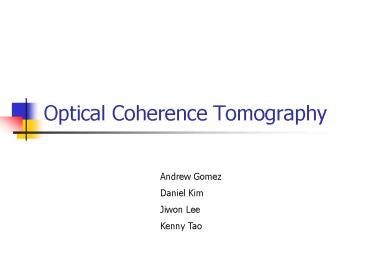Optical Coherence Tomography - PowerPoint PPT Presentation
1 / 20
Title:
Optical Coherence Tomography
Description:
Calibrate spectrogram plot to be able to calculate power reflectivity of surface. Obtain spectrogram (Fig 2) of reference arm only by blocking light from ... – PowerPoint PPT presentation
Number of Views:252
Avg rating:3.0/5.0
Title: Optical Coherence Tomography
1
Optical Coherence Tomography
Andrew Gomez Daniel Kim Jiwon Lee Kenny Tao
2
Theory of OCT
Exemplary model for a sample comprising a series
of discrete reflectors.
Schematic of a Michelson interferometer used in
OCT.
Izatt, Joseph A. Theory of Optical Tomography,
2006
3
Discrete Reflectors
For z0 at beamsplitter and
4
Fourier Domain OCT
5
Results
6
Experimental Setup
- First Experiment Low-Coherence Interferometry
- Second Experiment Optical Coherence Tomography
7
Light Source
8
Fiber Coupler (50/50 Beamsplitter)
9
Reference Reflector Detector Array (1-D CCD
Camera)
10
Microscope
- Dichroic Mirror
- Sample Stage
11
Methods
- Experiment 1 Low-Coherence Interferometry
- Purpose to obtain spectral interferogram data to
measure center wavenumber ko, standard deviation
?k and the power reflectivity of the slide
surface
12
Low Coherence Interferometry
- Procedure
- Adjust reference arm micrometer such that there
are no interference patterns across the spectrum. - Turn micrometer known distance till a fringe
pattern similar to the one shown in the theory
writeup is observed (Fig 1). - Calibrate spectrogram plot to be able to
calculate power reflectivity of slide surface. - Obtain spectrogram (Fig 2) of reference arm only
by blocking light from reaching the microscope.
Use to measure ko and ?k. The value of ko is
where the spectrum is at maximum and ?k is the
difference in wavenumber between maximum and 1/e
of maximum. - Turn on Fourier processing to observe A-scan
plot.
Figure 1
Figure 2
13
Methods
- Experiment II Optical Coherence Tomography
- Purpose to take two and three dimensional images
of internal biological tissue microstructure.
14
Optical Coherence Tomography
- Procedure
- Take B-scan of IR card using DC removal and
dual-axis scanning mirror. - Repeat for fingertip. Obtain 3D image by setting
scan pattern to rectangular volume. This
allows 100 sequential B-scans to be taken. - Stop scan and select volume image to obtain 3D
rendering of data. Try using with a coin. - Experiment using the 3D rendering program
3DView on acquired data.
15
LCI Results Single Reflector
16
LCI Results Reference Arm
17
LCI Results A-scan
18
OCT Results B-scan
0.2mm
19
OCT Results B-scan
Complex conjugate artifacts
Sweat glands
0.2mm
20
OCT Results 3D Scan

